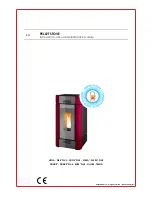
PAGE 5
OM-9603
Date Printed: February 15, 2008
Version: 1.02
IF THIS APPLIANCE IS NOT PROPERLY INSTALLED A HOUSE FIRE MAY RESULT. FOR YOUR SAFETY, FOLLOW THE
INSTALLATION DIRECTIONS. CONTACT LOCAL BUILDING OR FIRE OFFICIALS ABOUT RESTRICTIONS AND INSTALLATION
REQUIREMENTS IN YOUR AREA. PLEASE READ THIS ENTIRE MANUAL BEFORE YOU INSTALL AND USE YOUR NEW
APPLIANCE. FAILURE TO FOLLOW INSTRUCTIONS MAY RESULT IN PROPERTY DAMAGE, BODILY INJURY or DEATH.
CAUTIONS:
NEVER vent the appliance to other rooms or buildings. The appliance must be vented to the outside ONLY.
NEVER burn the appliance with the viewing door open.
FIRE EXTINGUISHER:
Every home should have at least one fire extinguisher. An approved "Class A-B-C" extinguisher should be mounted on the wall near an
exit and close to the appliance, but not so close that accessibility to the extinguisher could be blocked by a fire. Your local fire
department can advise you concerning the most appropriate location.
BUILDING AND FIRE CODES, PERMITS AND INSPECTIONS:
The installation of this gas appliance must comply with your local building and fire codes. Always contact you local Building Inspector
and/or Fire Department before beginning the installation process. If required, obtain a permit before installation and have the completed
installation inspected. Remember that not complying with building and/or fire codes may jeopardize your homeowner's insurance.
CHILDREN:
Do Not Allow Children to play near the appliance or with the controls. Severe burns may be inflicted by touching the door or glass, the
front, sides or top of the appliance. Train children to stay away from the appliance, and never leave the children unattended in the room
when the appliance is in operation.
SMOKE and CO-DETECTORS:
Install at least one smoke detector on each floor of your home to ensure your safety. It should be located away from the gas appliance
and close to the sleeping areas. Follow the smoke detector manufacturers' placement, installation and maintenance, instructions. Your
local Fire Department may provide assistance in selecting smoke detectors and CO-detectors. It is strongly recommended, for your
families protection, that a CO-detector be placed in all homes that utilize gas in any form. In the U.S.A. contact the Consumer Product
Safety Commission in Washington, D.C. 20207 for additional information.
THE APPLIANCE AREA MUST BE KEPT CLEAR FROM COMBUSTIBLE MATERIALS GASOLINE AND OTHER
FLAMMABLE VAPORS AND LIQUIDS.
SAFETY NOTICE
WARNING - OPERATION OF YOUR PEGASUS GAS STOVE WITH ICE OBSTRUCTIONS IN THE VENT SYSTEM IS
DANGEROUS. DO NOT OPERATE THE GAS APPLIANCE UNLESS YOU ARE SURE THE VENT SYSTEM IS CLEAR.
When using any gas appliance (LPG or NAT GAS) water is a byproduct of the combustion process.The amount of water varies slightly
depending on several factors. Generally an appliance which is rated at 40,000 BTU per hour will produce approximately 2 liters of water
vapor every hour. That’s a considerable amount of water which has to be dealt with. Under normal conditions this water is expelled into
the atmosphere as a warm vapor, via the vent system, and does not cause a problem. However, in very cold weather this vapor will
condense and freeze on any exposed surface it comes in contact with. This can cause serious problems, particularly in “Direct Vent”
appliances because the exhaust is typical only a few inches from the outside wall. In cold weather moisture vapors, which are exhausted,
can cause a serious buildup of frost and ice on surrounding surfaces. This can interfere with the venting. Extending the venting to
exhaust the gases further out from the wall is sometimes, but not always, an advantage. Extending the vent system too much can
present other design problems including the possibility of ice falling from eaves above. The amount of moisture being expelled cannot be
controlled by the manufacturer; It is far more dependent upon wind conditions etc. It is therefore the homeowner’s responsibility to ensure
that there is no excessive ice buildup during operation. Problems are most severe when there is no wind or when the prevailing wind
drives the exhaust gases back against the surfaces nearby. Cap design cannot control the movement of the vapors after they exit the
system. Under extremely cold conditions the vent cap itself can become so cold that the vapors condense and cause ice or frost buildup
on the vent cap. Severe icing of the cap system can affect the operation and safety of the appliance.
CAUTIONS
-
When operating your Pegasus gas stove during cold weather you must check the exhaust cap frequently to ensure it is
clear of ice buildup. Blaze King is not responsible for any damages caused by external ice buildup.
If the combustion, flame pattern, startup or shut down characteristics of your stove change, it could be a sign of ice buildup in the vent
system. If this occurs notify your Blaze King Dealer. DO NOT operate your stove if there is excessive ice buildup on the vent cap.
Ensure that any ice or frost buildup on surfaces around the exhaust are not causing problems or damage.
NOTICE - COLD WEATHER OPERATION






































